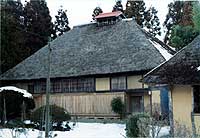
| Specified type | Prefecture designation |
|---|---|
| Type | Building |
| Designated date | May 7, 1996 |
| Specified details | |
| quantity | 1 case 4 buildings |
| location | Ichinoseki City Senjocho Koshinji Fudo |
| owner | Kazuko Murakami |
| Holding group | |
| Management organization | |
| home page |
Overview
Murakami family houses have a genealogy in the houses of the former samurai class who have been here in the early modern era.
In that sense, it is extremely valuable in that it is characteristic of the northern area of the former Sendai Territories and has a typical floor plan shape for large upper-class houses.
There is no specific document to indicate the construction age of Murakami's house, but the end of the 18th century can be regarded as a stupid old-fashioned house in terms of the layout form etc.
Although some traces of retrofits are seen, their preservation is generally very good.
In addition to the main house, the attached facilities such as stables, forts and sheds are well managed and preserved, which is an important component as a historical residence landscape.
For Murakami house, in the local it has been commonly referred to as "搦道 mansion (entwined How mansion)", is unknown about the exact family.
However, as estimated from the size and shape of the house and the main building, Murakami, who became an indigenous resident of the early modern era and was active as a development 100-year-old village in Koshina, about the current house, It can be viewed as having a genealogy to those listed as “Nishiyayashiki, Naiyoyoshiki, Kiyojuro, and ancestral Murakami Hirahira”.
From this point of view, the Murakami House House is an extremely valuable cultural heritage and relics in the history of architecture and culture in this prefecture, and also in the history of private house architecture.
(Part 1 of the first tangible cultural property designation standard building 3)
